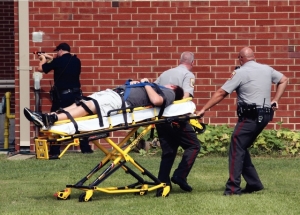Officers, school try out policy in 'real-life' practice scenario
By John Joyce
Published in News on August 5, 2012 1:50 AM

News-Argus/BOBBY WILLIAMS
Law enforcement personnel remove an injured victim as a fellow officer keeps his gun trained on the building during an exercise Friday.
The stillness shattered at exactly 9:40 a.m. as the report came in -- shots fired, man with a gun on the campus of the old Wayne Community College.
A mass shooting and potential hostage situation was unfolding at Work Source East Vocational Rehabilitation school.
Within minutes of the simulated 911 call, the campus on U.S. 70 was filled with noise. Alarms were ringing inside buildings. Shots were heard. Radio traffic erupted over local law enforcement airwaves. Two explosions rocked the courtyard and more gunfire rang out.
At 9:50 a.m., a single patrol car spewed gravel and scraped to a halt along the dirt road on the east side of the school. In an instant, a line of vacant police cars idled one behind the other. Officers huddled behind a mound of dirt, checking weapons and assessing the situation.
Victims were known to be wounded inside, some feared dead. The location of the shooter, his arsenal, his intentions, his accomplices, remained unknown.
*
It seemed like the real thing.
And it was meant to be.
The six local law enforcement agencies who gathered Friday wanted to test their plans, their reaction time, their ability to respond -- just in a case they got one of those calls -- like the one at Columbine High School in Colorado or the one at Virginia Tech.
They were there because Work Source East asked for the test. In the wake of the mass murders at other schools, local officials wanted to be prepared, to take the procedures from manuals and policies to a real-life test run to see if the "what if" would show that the school was ready in case of a real-life distress call.
The final results won't be in for a few weeks -- after officials take a close look at the data.
But, for now, Tara Myers, Work Source East facility director, said she is even more confident that the school, which has 180 students and at least 35 employees, and local law enforcement are ready just in the case the unthinkable should happen here.
"We feel more prepared. It's one thing to read about the procedures but putting it all into motion really helped," Ms. Myers said.
*
More than 40 minutes into the scenario, at least three were dead.
Goldsboro police and Wayne County sheriff's deputies were in place across the complex, weapons trained on doors and windows. Many were inside, taking fire, attempting to contain the suspect.
EMS moved in to evacuate the wounded to a nearby make-shift triage station. While extricating victims, they came under fire. The shooter, with a high-powered rifle and scope, took aim and fired at the first responders, wounding two. Their bodies lay motionless beneath a victim atop a stretcher, strapped to a backboard and with no means of escape. Everything slowed.
Radio traffic was brief -- one officer down, multiple wounded.
Goldsboro police Commander of Investigations Maj. Theresa Chiero took control of the scene and established contact with the hostage taker -- a job she received on the fly, with no time to prepare just the right words or actions.
She spoke with the shooter via a radio he had taken from the fallen officer. That also meant he could monitor communications between the officers, EMS and the fire department.
The suspect had by this time been isolated, but with hostages. He still had explosives and had already shown a willingness to use them. He had and threatened to continue to kill at random.
"I've got the door rigged," chirped a nearby officer's radio. The hostage taker was demanding that SWAT and other officers back off.
"This hostage here, she's pregnant and tied to the door, don't try to come in here."
He threatened to detonate his devices. He demanded a phone call and water for the hostages, one of whom was diabetic. This was by no means sympathy. The hostages and the expolsives remained the shooter's only leverage.
Officers were still in the building, staked out behind trees and brick corners. The shooter threatened to fire on SWAT team members sneaking into position in a nearby garage. More wounded were evacuated, shrouded by officers with drawn weapons and wearing tense faces.
Negotiations resumed a short time later. From the command post set up inside one of the school buildings, the negotiator facilitated the efforts, while the major, Goldsboro police Chief Jeff Stewart and members of the Wayne County Sheriff's Office, Emergency Medical Service and Goldsboro Fire Department coordinated the response.
And as suddenly as it began, the standoff was over. Weapons were holstered and bodies started moving toward the building.
"Suspect in custody, all secure."
*
The exercise was over. Debriefing would take place over lunch.
For now, the analysis was anecdotal, with agencies examining themselves for areas where they needed more work or could refine their approaches.
The in-depth review will come later.
It is part of the job, the officers say. They will take a hard look at the results themselves, with an eye to refining the "what if" to prepare for the reality.
"There are things we can work on," Stewart said, following the exercise. "The reason we do (a scenario) like this is so that we can better prepare for the real thing."
